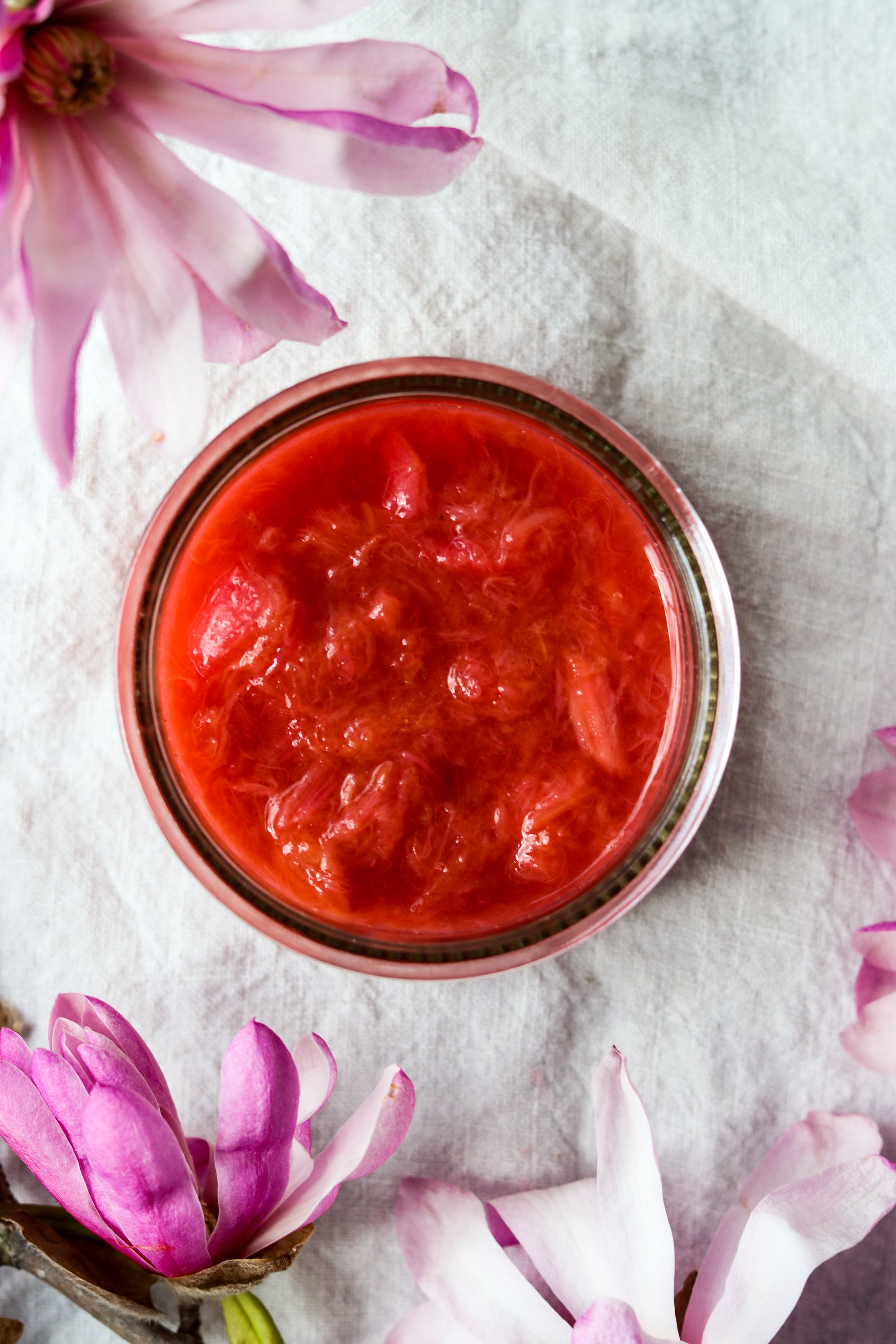CINNAMON OAT CREPES
WITH MAGNOLIA RHUBARB COMPOTE
Crepes have been a staple in my Scandinavian household since I was born. Known to my family as Finnish pancakes with a twist, these delicate thin pancakes are rolled up with a bitter/sweet/spicy magnolia rhubarb compote. The crepes are gluten free and made using oat flour and loaded with fibre, antioxidants, vitamin C, B vitamins, calcium and magnesium.
Adding edible and medicinal flowers to recipes is one of my tricks to add more nutrients into the body.
You can find the list of Ontario edible flowers at the bottom of the page.
Equipment Needed:
Whisk
Flat spatula
Medium size ladle
Small Pot
Griddle or non stick pan
Medium size bowl
INGREDIENTS:
Magnolia Rhubarb Compote:
5-6 stalks of rhubarb (chopped)
petals from 2 flowers of the saucer magnolia (Magnolia soulangeana) **
zest from one lemon
juice from 1 lemon
1 tbsp maple syrup or honey
1 inch piece of ginger (shredded)
Cinnamon Crepes
2 eggs
1 cup almond milk**
2 tbsp melted ghee or grass fed butter
1 tbsp vanilla
1 tbsp maple syrup
1 cup oat flour (sifted) **
2 tsp cinnamon
METHOD:
Magnolia rhubarb compote
Add the rhubarb, magnolia petals, lemon zest, lemon juice, ginger and maple syrup to a small pot
Bring to a boil and then reduce to a low simmer while you are making the crepes (about 10-15 min)
Stir often to make sure the juice is blending in
Cinnamon Crepes
Whisk together the eggs, almond milk, melted ghee, vanilla, ginger and maple syrup in a medium size bowl
Sift in the oat flour, cinnamon and salt
Stir until just combined
The consistency should be very thin. If you feel like a bit more flour is needed then add a couple tablespoons at a time until you reach your desired consistency
Reminder - stir the compote or take off the heat at this point to make sure it does not over cook
Make sure the griddle or small pan is on medium heat and let the pan warm up with a dab of butter for a few minutes
Test the pan with small amount of batter to start off with your “first crepe”
Keep in mind that the first crepe is always a failure….snack on it while you are making the rest of the crepes
Add a scoop of the batter to the pan and swirl it around to coat the whole bottom
The thinner the crepe, the better the texture
Flip once you see the crepe start to lift a bit from the bottom of the pan. About 1-2 minutes and keep on for about 30 seconds for the other side. The colour should be golden brown
Serve warm magnolia rhubarb compote
Enjoy every bite!
** Do not eat Magnolia flowers if you have allergies to certain flowers or if you are pregnant.
You can make this compote without flowers as it still tastes just as great!
**You can use any type of milk you wish to use in this recipe (dairy milk, coconut milk, cashew milk, oat milk or hemp milk)
**You can use regular flour instead of oat flour with the same measurements if that is all you have.
EDIBLE FLOWERS
Edible flowers can add colour, texture and flavour to salads, soups, desserts, decorations and cocktails.
They have a wide range of flavour profiles from spicy (hot), peppery, neutral, sweet and bitter.
Make sure to pick them in the morning as they have the most moisture then. You can keep them in the fridge on a damp paper towel for up to a week.
When you are harvesting in the wild or in the garden, make sure to properly identify the flower and how to eat it before consuming. There are poisonous flowers that you should not eat.
Avoid flowers that have been sprayed with chemicals and pesticides. Make sure they are organic or harvested in fields or forests and not near roads or anywhere chemicals may have been used.
The list of Ontario Wild and Garden Flowers:
This is a starter list with a wide variety of flavours and colours that are widely available to enjoy.
Angelia (Angelica archangelica)
Begonia (Begonia x tuberhybrida) and wax (B. x semperflorens-cultorum)
Borage (Borago officnialis)
Calendula (Calendula officinalis)
Chamomile (Matricaria chamomilla syn. M. recutita)
Chervil (Anthriscus cerefolium)
Chicory (Cichorium endivia & C. intybus)
Chickweed (Stellaria media)
Chive flower top (Allium schoenoprasum)
Chrysanthemum (Leucanthemum coronarium)
Dandelion (Taxacum officinalis)
Clover (Trifolium spp.)
Day lily (Hemerocallis spp.)
Echinacea (Echinacea purpurea)
Hollyhock (Alcea rosea)
Honeysuckle (Lonicera japonica)
Impatiens (Impatiens walleriana)
Johnny-jump-up (Viola tricolor)
Lavender (Lavandula angustifolia)
Lilac (Syringa vulgaris)
Magnolia (Magnolia soulangeana)
Nasturtiums (Tropaeolum majus)
Pansey (Viola x wittrockiana)
Pea flowers (Pisum sativum)
Primrose (Primula vulgaris)
Safflower (Carthamus tinctorius)
Sunflower (Helianthus annuus)
Squash blossoms - courgette flowers
Viola (Viola spp.)
Wild Bergamot (Monarda fistulosa)
Wild Rose (rose spp.)
**Do not eat if you are allergic to flowers, pregnant or unsure if it has been contaminated with chemicals or pollutants





